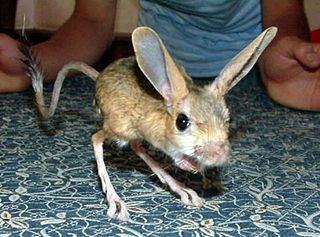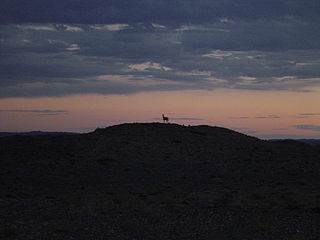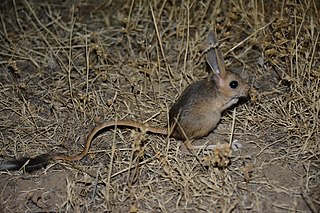
Jerboas are hopping desert rodents found throughout North Africa and Asia, and are members of the family Dipodidae. They tend to live in hot deserts.

The Eastern Gobi desert steppe is a deserts and xeric shrublands ecoregion in Mongolia and northern China. It is the easternmost of the ecoregions that make up the larger Gobi Desert. It lies between the more humid Mongolian–Manchurian grassland on the north, east, and southeast, and the drier Alashan Plateau semi-desert to the west.

The four-toed jerboa is a rodent of the family Dipodidae and genus Scarturus that has four digits. Four-toed jerboas are native to Egypt and Libya. They live in coastal salt marshes and dry deserts.

Dipodoidea is a superfamily of rodents, also known as dipodoids, found across the Northern Hemisphere. This superfamily includes over 50 species among the 16 genera in 3 families. They include the jerboas, jumping mice, and birch mice. Different species are found in grassland, deserts, and forests. They are all capable of saltation, a feature that is most highly evolved in the desert-dwelling jerboas.

The genus Allactaga contains the five-toed jerboas of Asia. They are small mammals belonging to the order of rodents. They are characteristically known as the hopping rodents of the desert and semi-arid regions. They have long hind feet, short forelimbs, and walk upright. They have large ears in comparison to their body size and a large tail. The tail assists and serves as support when the jerboa is standing upright. The jerboa body length ranges from 5–15 cm and has a tail ranging from 7–25 cm. The "forelimbs of the jerboa serve as a pair of hands for feeding, grooming, etc." Jerboas use their nose to burrow and push the dirt when looking for food. The male jerboa is usually larger in size and weight in comparison to the female jerboa. The pelt of the jerboa is either silky or velvety in texture and light in color, the coloration helps camouflage into surroundings to avoid predators. All members of the genus have five toes except for a single species, the Four-toed Jerboa, Allactaga tetradactyla of Northern Africa.
The long-tailed dwarf hamster is a species of rodent in the family Cricetidae. It is found in China, Kazakhstan, Mongolia, and Russia.
The Gobi jerboa is a species of rodent in the family Dipodidae. It is found in China and Mongolia. Its natural habitats are temperate grassland and temperate desert.
Hotson's jerboa or the Iranian jerboa, is a species of rodent in the family Dipodidae. It is found in Afghanistan, Iran, and Pakistan.

The great jerboa is a species of rodent in the family Dipodidae. It is found in Kazakhstan, Russia, Turkmenistan, Ukraine and Uzbekistan. It mainly lives in deserts.

The northern three-toed jerboa is a species of rodent in the family Dipodidae. It is the only extant species within the genus Dipus. It ranges across Iran, Uzbekistan, Turkmenistan, Kazakhstan, Russia, China and Mongolia. A common species, the International Union for Conservation of Nature rates it as being of "least concern".
The Chinese jumping mouse is a species of rodent in the family Dipodidae. It is monotypic within the genus Eozapus. It is endemic to China where its natural habitat is temperate forests, steppes and meadows in mountainous regions. It is tolerant of some degree of habitat destruction, and the International Union for Conservation of Nature has assessed its conservation status as being of "least concern".

The greater Egyptian jerboa is a species of rodent in the family Dipodidae. It is found in Algeria, Egypt, Libya, Morocco, Saudi Arabia, Tunisia, and is possibly extinct in the Negev Desert of Israel. Its natural habitats are subtropical or tropical dry shrubland, sandy shores, and arable land.

The thick-tailed pygmy jerboa is a species of rodent in the family Dipodidae. It is found in China, Kazakhstan, and Mongolia. Its natural habitats are temperate grassland and temperate desert. It is threatened by habitat loss. It is listed by the IUCN as being "least concern".
Kozlov's pygmy jerboa is a species of rodent in the family Dipodidae. It is found in northwestern China and southern and eastern Mongolia. Its natural habitat is temperate desert.
Andrews's three-toed jerboa, or the Mongolian jerboa, is a species of rodent in the family Dipodidae. It is found in China and Mongolia.

The thick-tailed three-toed jerboa is a species of rodent in the family Dipodidae. It is found in China, Kazakhstan, Russia, Turkmenistan, Ukraine, and Uzbekistan. Its typical habitat is steppe, desert and mountain grassland where it is often found among saltbush and Artemisia in sandy or clayey soils.

Allactaginae is a subfamily of rodents.

Williams's jerboa is a species of jerboas native to Afghanistan, Armenia, Azerbaijan, Iran and Turkey.

The desert hare is a species of hare found in Central Asia, Northwest China, and the western Indian subcontinent. Little is known about this species except that it inhabits grassland and scrub areas of desert and semi-desert. The International Union for Conservation of Nature has assessed its conservation status as being of "least concern."











